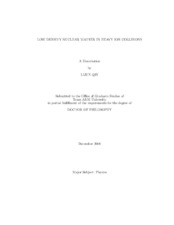| dc.description.abstract | The symmetry energy is the energy difference between symmetric nuclear matter
and pure neutron matter at a given density. Around normal nuclear density, i.e.
p/p0 =1, and temperature, i.e. T = 0, the symmetry energy is approximately 23.5
MeV/nucleon for finite nuclear matter and 30 MeV/nucleon for infinite nuclear matter,
but at other densities, the symmetry energies are very poorly understood. Since
the symmetry energy is very important in understanding many aspects of heavy ion
reactions, structure, and nuclear astrophysics, many different models have been developed
and some predications of the density dependence of symmetry energy have been
made. Intermediate energy heavy ion collisions provide a unique tool to probe the
nuclear equation of state. The initial compression and the thermal shock in Fermi-
Energy heavy ion collisions lead naturally to the production of nucleonic matter at
varying temperatures and densities which are interesting in this context. Since the
light particle emission during this stage witnesses each stage of the reaction, it carries
essential information on the early dynamics and on the degree of equilibration at
each stage of the reaction. The kinematic features and yields of emitted light particles
and clusters in the invairant velocity frame have been exploited to probe the nature
of the intermediate system and information on the Equation Of State (EOS) with
emphasis on the properties of the low density participant matter produced in such collisions. In order to pursue this effort and broaden the density range over which the
symmetry energies are experimentally determined we have now carried out a series
of experiments in which the reactions of 112Sn and 124Sn with projectiles, ranging
from 4He,10B, 20Ne, 40Ar to 64Zn, all at the same energy per nucleon, 47 Mev/u, were
performed.
In this series of experiments different collision systems should lead to different
average densities. By careful comparisons of the yields, spectra and angular distributions
observed for particle emission from these different systems we attempted to
cleanly separate early emission resulting from nucleon-nucleon collisions from that
resulting from evaporation from the thermalized system and obtain a much cleaner
picture of the dynamic evolution of the hotter systems. The Albergo Model has
been used to calculate the density and temperature, symmetry free energies with the
isoscaling technique for systems with different N/Z ratios. Those are compared with
Roepke Model results. Also other models like VEOS, Lattimer, and Shen-Toki have
been added to calculate the alpha mass fraction in order to understand the properties
of low density matter further. | en |


